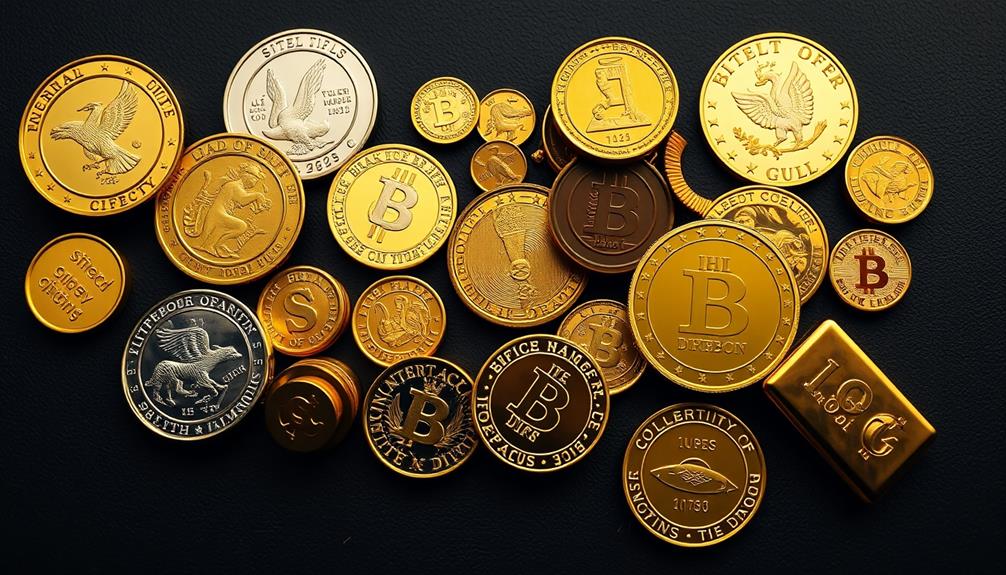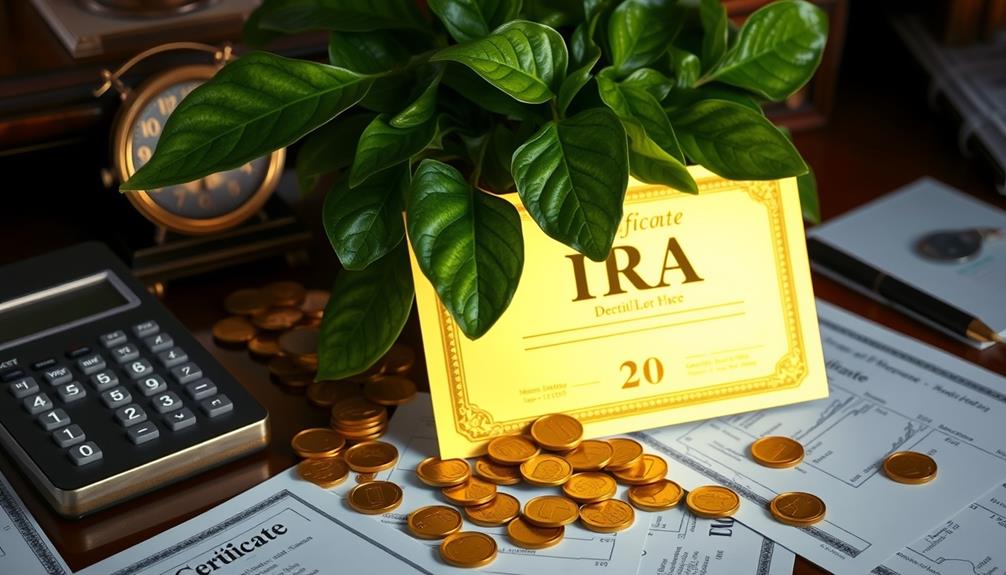A Gold IRA allows you to invest in physical gold and other precious metals to protect against inflation and market volatility. There are options such as Traditional, Roth, or Self-Directed Gold IRAs, each with specific tax advantages. To set up a Gold IRA, you need to choose a specialized custodian, fund your account through contributions or rollovers, and ensure your investments meet IRS requirements. Remember, the metals must be stored in IRS-approved depositories. If you’re interested in learning more about the benefits, costs, and efficient management of your investments, you’ll find plenty of insights ahead.
Key Takeaways
- Gold IRAs allow investment in physical gold and precious metals, offering diversification and protection against inflation and market volatility.
- There are various types of Gold IRAs, including Traditional, Roth, Self-Directed, and SEP, each with unique tax advantages and contribution limits.
- Setting up a Gold IRA requires choosing a reputable custodian, funding through rollovers or contributions, and adhering to IRS purity standards.
- Precious metals must be stored in IRS-approved depositories; home storage is prohibited, ensuring compliance and security of your assets.
- Be aware of costs associated with Gold IRAs, including setup, custodial, storage, transaction, and transfer fees, which vary by provider.
Overview of Gold IRAs

If you're considering diversifying your retirement portfolio, a Gold IRA might be an attractive option. This specialized retirement account allows you to hold physical gold and other precious metals, like silver, platinum, and palladium.
Unlike traditional IRAs, a Gold IRA must be managed by a custodian who specializes in precious metals, as these investments can't be housed in standard brokerage accounts. Gold IRAs offer potential for long-term capital appreciation and act as a safe haven during market volatility, providing a hedge against inflation and economic downturns long-term capital appreciation.
Eligible investments include IRS-approved bullion and coins that meet specific purity standards, such as gold being at least 99.5% pure. This makes a Gold IRA an appealing choice for those looking to add tangible assets to their investment portfolio.
You can choose between a Traditional Gold IRA, which offers tax-deferred growth, and a Roth Gold IRA, which allows for tax-free withdrawals during retirement.
However, it's essential to remember that physical gold must be stored in an IRS-approved depository; you can't keep it at home or in personal safes. Additionally, custodial fees may apply for managing your Gold IRA, so it's wise to factor these costs into your overall investment strategy.
Benefits of Gold IRAs

Investing in a Gold IRA brings a host of benefits that can greatly enhance your retirement strategy. One of the primary advantages of investing in Gold IRAs is portfolio diversification. Including physical gold and precious metals in your investment mix can reduce overall risk and volatility compared to traditional assets like stocks and bonds.
Moreover, gold IRAs can protect against inflation and market downturns, making them a strategic choice in today's economic landscape, especially for those considering potential for higher returns with gold as a long-term investment.
Gold has historically maintained its value during inflationary periods, serving as a reliable hedge against rising prices and economic uncertainty. This long-term investment often preserves wealth better than many other asset classes during economic downturns, providing you with essential financial security.
Additionally, Gold IRAs offer tax advantages similar to traditional IRAs. You can enjoy tax-deferred growth with a Traditional Gold IRA or tax-free withdrawals with a Roth Gold IRA upon retirement. This can greatly enhance your retirement planning efforts.
Types of Gold IRAs

When exploring the types of Gold IRAs, you'll find several options tailored to different investment needs and goals.
Each type of Gold IRA offers unique benefits and features, which can help you make informed investment decisions.
For instance, many reputable companies, such as Noble Gold, provide a range of precious metal investment options and educational resources that can assist you in making the right choice.
Here's a brief overview:
- Traditional Gold IRA: Funded with pretax dollars, this option allows for tax-deferred growth until you start taking distributions, typically after age 59½.
- Roth Gold IRA: This uses after-tax contributions and offers tax-free withdrawals in retirement, provided you meet certain conditions.
- Self-Directed Gold IRA: This type gives you greater flexibility, allowing you to control your assets through an IRA-LLC structure, enabling personalized investment decisions.
- SEP Gold IRA: Designed for self-employed individuals and small business owners, this option allows for higher contribution limits—up to 25% of compensation or $66,000 in 2023.
Setting Up a Gold IRA

Setting up a Gold IRA can be a straightforward process when you follow the right steps. First, choose a reputable custodian that specializes in precious metals, then complete the necessary paperwork to open a self-directed IRA account. This allows you to manage your investments effectively.
Next, you'll need to fund your Gold IRA. You can do this through direct contributions, rollovers from existing retirement accounts, or transfers from other IRAs. Just remember to adhere to the IRS contribution limits, which are $6,500 for 2023 and $7,000 for those aged 50 and above.
Once your account is funded, select IRS-approved precious metals, such as gold, silver, platinum, or palladium, guaranteeing the gold is at least 99.5% pure.
After purchasing these metals, it's essential that they're stored in an IRS-approved depository, as home storage isn't allowed under IRS regulations.
Lastly, regularly monitor your Gold IRA investments and stay informed about any changes in IRS guidelines. This will help you maintain compliance with IRS regulations and maximize the potential for growth in your investment.
Funding Your Gold IRA

When you're ready to fund your Gold IRA, understanding the rollover process and contribution limits is key.
You can transfer funds from existing retirement accounts without tax penalties, but keep in mind the annual contribution cap of $6,500—or $7,500 if you're 50 or older.
Knowing these details will help you make informed decisions as you build your gold investment.
Rollover Process Explained
Transferring funds into a Gold IRA through the rollover process can be a smart move for diversifying your retirement portfolio. This method allows you to transfer funds from existing retirement accounts, like 401(k)s or Traditional IRAs, without immediate tax penalties if completed within 60 days.
To guarantee a smooth rollover, follow these steps:
- Choose Your Custodian: Select a reputable Gold IRA custodian to manage your account and assist with the rollover.
- Initiate a Direct Transfer: Request a direct transfer, which sends funds straight from your old account to your new Gold IRA custodian, avoiding withholding taxes and penalties.
- Adhere to Rollover Rules: Remember, the IRS allows only one rollover per 12-month period per account, so plan accordingly to avoid tax implications.
- Invest in IRS-Approved Metals: Use the rolled-over funds to purchase physical gold, silver, platinum, or palladium that meets purity standards.
Contribution Limits Overview
Understanding the contribution limits for your Gold IRA is vital for effective retirement planning. For 2023, the annual contribution limit is $6,500, with an extra $1,000 allowed for individuals aged 50 and above, known as the catch-up contribution.
Keep in mind that contributions to your Gold IRA count toward the overall contribution limits for all your retirement accounts, including Traditional and Roth IRAs.
When you contribute to a Gold IRA, you can use pre-tax dollars if you're funding a Traditional IRA or post-tax dollars for a Roth IRA. This choice affects how your withdrawals will be taxed later on.
It's also important to stay updated with IRS updates, as these contribution limits can change annually due to inflation adjustments.
One advantage of a Gold IRA is the ability to perform rollovers from existing retirement accounts without impacting your annual contribution limits. This means you can fund your Gold IRA additionally, without penalties, making it a flexible option for diversifying your retirement portfolio.
Always consult with a financial advisor to make sure you're maximizing your contributions effectively.
Storing Precious Metals

Storing precious metals in a Gold IRA is a vital step in protecting your investment. To guarantee compliance with IRS regulations, you must store your precious metals in IRS-approved depositories, as home storage isn't allowed.
Here are some key considerations for storing precious metals:
- Purity Standards: Confirm your gold is at least 99.5% pure, silver at 99.9%, and palladium at 99.95% to meet IRA requirements.
- Storage Fees: Be aware that custodians typically charge storage fees, which can vary based on the depository and the amount of physical metals stored.
- Insurance: It's important to have insurance for your precious metals to protect against theft or loss. Most custodians offer options for insuring your assets.
- Record-Keeping: Proper documentation of all transactions and storage arrangements is significant. Maintain clear records to guarantee compliance and facilitate the safe retrieval of your assets.
Costs and Fees of Gold IRAs

When you immerse yourself in the world of Gold IRAs, it's essential to keep an eye on the costs and fees that come with setting up and maintaining your account. Understanding these expenses can help you make informed decisions and avoid any unwelcome surprises.
Here's a breakdown of the typical costs associated with a Gold IRA:
| Fee Type | Cost Range |
|---|---|
| Setup Fee | $50 – $300 |
| Annual Custodial Fees | $100 – $300 |
| Storage Fees | $100 – $500 |
| Transaction Fees | 1% – 5% of transaction |
| Transfer Fees | $50 – $100 per transfer |
You'll usually face a one-time setup fee, which varies by custodian. Annual custodial fees cover account management and can add up quickly. If you're storing physical gold, expect storage fees at an IRS-approved depository, influenced by the amount and value of your metals. Additionally, transaction fees may apply when buying or selling precious metals, and transfer fees could arise when moving funds from other accounts to your Gold IRA. Always review these costs to guarantee a successful investment journey.
Frequently Asked Questions
What Is the Downside of a Gold Ira?
Imagine holding a treasure, yet it comes with hidden costs. A gold IRA's downsides include higher fees, market volatility, lack of income generation, and strict IRS regulations, which can complicate your investment journey considerably.
What Is the Truth About Gold Iras?
The truth about Gold IRAs is that they offer unique investment opportunities, allowing you to diversify your portfolio. However, you need to evaluate risks like market volatility, fees, and IRS regulations before investing.
How Much Money Do You Need to Start a Gold Ira?
To start a Gold IRA, having between $10,000 and $25,000 is often recommended. This amount helps cover initial investments and fees, ensuring you're set for a more effective and secure investment strategy.
How to Get Started With a Gold Ira?
To get started with a Gold IRA, you'll need to choose a reputable custodian, open a self-directed account, fund it, select approved precious metals, and guarantee proper storage in an IRS-approved depository.
Conclusion
In your journey toward securing a brighter financial future, a Gold IRA can be a shining beacon. By understanding its benefits, types, and setup process, you're well-equipped to make informed decisions. Remember, each step you take is a step closer to diversifying your portfolio and protecting your wealth. So, as you consider this golden opportunity, keep your eyes on the prize and your strategy sharp—your retirement deserves nothing less than the best!
Helen brings a wealth of experience in investment strategy and a deep passion for helping individuals achieve their retirement goals. With a keen understanding of market dynamics, Helen has been instrumental in shaping the vision and direction of Gold IRA Markets. She specializes in creating innovative solutions that align with our clients’ long-term investment objectives.










